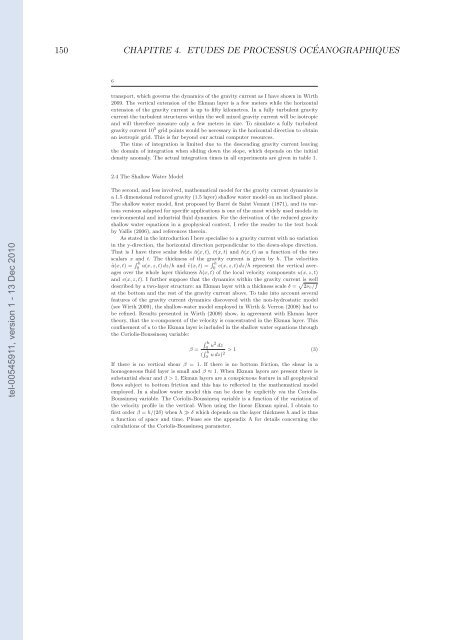Etudes et évaluation de processus océaniques par des hiérarchies ...
Etudes et évaluation de processus océaniques par des hiérarchies ...
Etudes et évaluation de processus océaniques par des hiérarchies ...
You also want an ePaper? Increase the reach of your titles
YUMPU automatically turns print PDFs into web optimized ePapers that Google loves.
150 CHAPITRE 4. ETUDES DE PROCESSUS OCÉANOGRAPHIQUES<br />
6<br />
transport, which governs the dynamics of the gravity current as I have shown in Wirth<br />
2009. The vertical extension of the Ekman layer is a few m<strong>et</strong>ers while the horizontal<br />
extension of the gravity current is up to fifty kilom<strong>et</strong>res. In a fully turbulent gravity<br />
current the turbulent structures within the well mixed gravity current will be isotropic<br />
and will therefore measure only a few m<strong>et</strong>ers in size. To simulate a fully turbulent<br />
gravity current 10 5 grid points would be necessary in the horizontal direction to obtain<br />
an isotropic grid. This is far beyond our actual computer resources.<br />
The time of integration is limited due to the <strong>de</strong>scending gravity current leaving<br />
the domain of integration when sliding down the slope, which <strong>de</strong>pends on the initial<br />
<strong>de</strong>nsity anomaly. The actual integration times in all experiments are given in table 1.<br />
2.4 The Shallow Water Mo<strong>de</strong>l<br />
tel-00545911, version 1 - 13 Dec 2010<br />
The second, and less involved, mathematical mo<strong>de</strong>l for the gravity current dynamics is<br />
a 1.5 dimensional reduced gravity (1.5 layer) shallow water mo<strong>de</strong>l on an inclined plane.<br />
The shallow water mo<strong>de</strong>l, first proposed by Barré <strong>de</strong> Saint Venant (1871), and its various<br />
versions adapted for specific applications is one of the most wi<strong>de</strong>ly used mo<strong>de</strong>ls in<br />
environmental and industrial fluid dynamics. For the <strong>de</strong>rivation of the reduced gravity<br />
shallow water equations in a geophysical context, I refer the rea<strong>de</strong>r to the text book<br />
by Vallis (2006), and references therein.<br />
As stated in the introduction I here specialise to a gravity current with no variation<br />
in the y-direction, the horizontal direction perpendicular to the down-slope direction.<br />
That is I have three scalar fields ũ(x, t), ṽ(x, t) and h(x, t) as a function of the two<br />
scalars x and t. The thickness of the gravity current is given by h. The velocities<br />
ũ(x, t) = R h<br />
0 u(x, z, t) dz/h and ṽ(x, t) = R h<br />
0 v(x, z, t) dz/h represent the vertical averages<br />
over the whole layer thickness h(x, t) of the local velocity components u(x, z, t)<br />
and v(x, z, t). I further suppose that the dynamics within the gravity current is well<br />
<strong>de</strong>scribed by a two-layer structure: an Ekman layer with a thickness scale δ = p 2ν v/f<br />
at the bottom and the rest of the gravity current above. To take into account several<br />
features of the gravity current dynamics discovered with the non-hydrostatic mo<strong>de</strong>l<br />
(see Wirth 2009), the shallow-water mo<strong>de</strong>l employed in Wirth & Verron (2008) had to<br />
be refined. Results presented in Wirth (2009) show, in agreement with Ekman layer<br />
theory, that the x-component of the velocity is concentrated in the Ekman layer. This<br />
confinement of u to the Ekman layer is inclu<strong>de</strong>d in the shallow water equations through<br />
the Coriolis-Boussinesq variable:<br />
β =<br />
R h<br />
0 u2 dz<br />
( R > 1 (3)<br />
h<br />
0 u dz)2<br />
If there is no vertical shear β = 1. If there is no bottom friction, the shear in a<br />
homogeneous fluid layer is small and β ≈ 1. When Ekman layers are present there is<br />
substantial shear and β > 1. Ekman layers are a conspicuous feature in all geophysical<br />
flows subject to bottom friction and this has to reflected in the mathematical mo<strong>de</strong>l<br />
employed. In a shallow water mo<strong>de</strong>l this can be done by explicitly via the Coriolis-<br />
Boussinesq variable. The Coriolis-Boussinesq variable is a function of the variation of<br />
the velocity profile in the vertical. When using the linear Ekman spiral, I obtain to<br />
first or<strong>de</strong>r β = h/(2δ) when h ≫ δ which <strong>de</strong>pends on the layer thickness h and is thus<br />
a function of space and time. Please see the appendix A for d<strong>et</strong>ails concerning the<br />
calculations of the Coriolis-Boussinesq <strong>par</strong>am<strong>et</strong>er.
















